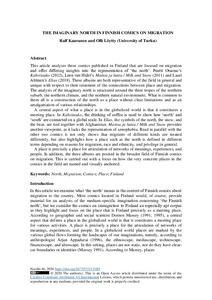The Imaginary North in Finnish Comics on Migration
Löytty Olli; Kauranen Ralf
https://urn.fi/URN:NBN:fi-fe2021042827407
Tiivistelmä
This article analyses three comics published in Finland that are focused on migration and offer differing insights into the representation of ‘the north’: Pentti Otsamo’s Kahvitauko (2012), Leen van Hulst’s Maitoa ja lunta / Milk and Snow (2011) and Lauri Ahtinen’s Elias (2018). These albums are both representative of the field in general and unique with respect to their treatment of the connections between place and migration. The analysis of the imaginary north is structured around the three tropes of the northern suburb, the northern climate, and the northern natural environment. What is common to them all is a construction of the north as a place without clear limitations and as an amalgamation of various relationships.
A central aspect of what a place is in the globalized world is that it constitutes a meeting place. In Kahvitauko, the drinking of coffee is used to show how ‘north’ and ‘south’ are connected on a global scale. In Elias, the symbols of the north, the snow, and the bear, are tied together with Afghanistan. Maitoa ja lunta / Milk and Snow provides another viewpoint, as it lacks the representation of xenophobia. Read in parallel with the other two comics it not only shows that migrants of different kinds are treated differently, but also highlights how a place such as the north is defined in different terms depending on reasons for migration, race and ethnicity, and privilege in general.
A place is precisely a place for articulation of networks of meanings, experiences, and people. In addition, the three albums are posited in the broader field of Finnish comics on migration. This is carried out with a focus on how the very concrete places in the comics in the field are named and visually anchored.
Kokoelmat
- Rinnakkaistallenteet [27094]
